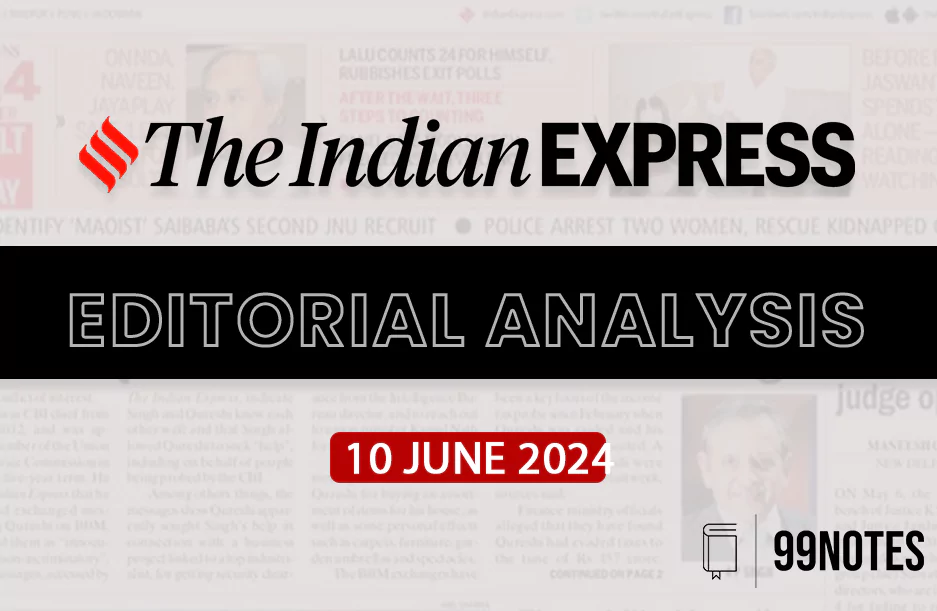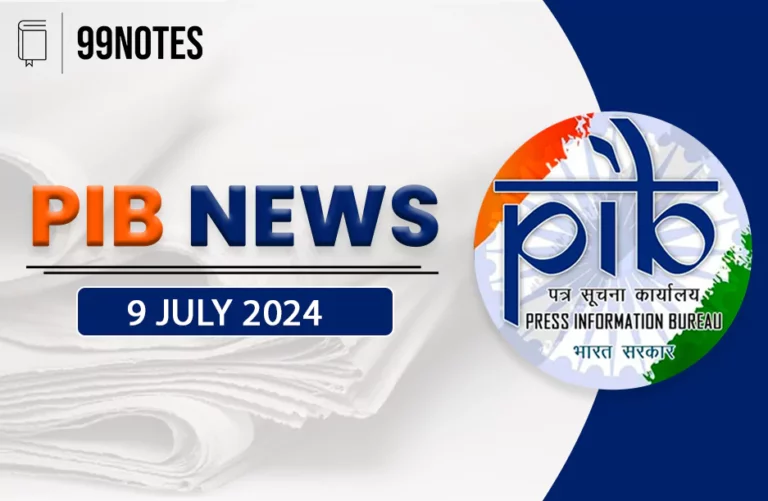10 June 2024 : Indian Express Editorial Analysis
1. Moving on from the past
| Topic: GS2 – Governance – Government policies– Interventions for development in various sectors |
| Context: |
|
The Aftermath of Elections and Governance Realities:
- As the fervor of the elections subsides, the routine yet critical aspects of governance come into sharper focus. The recent election campaign, marked by a renewed emphasis on identity politics, unfortunately, neglected the pressing policy decisions that the country must confront.
- The Prime Minister’s campaign largely focused on vilifying minorities, raising questions about the commitment to the inclusive development slogan “sabka saath, sabka vikaas.”
- Concurrently, the Congress party’s late embrace of a caste census highlights a political shift, especially after Bihar’s implementation of such a census, which is expected to usher in social justice and prosperity.
The Weight of Identity Politics:
- Identity politics, which unequivocally impacts the lives of those disadvantaged by their social status, often overshadows crucial contemporary issues.
- This backward-looking obsession detracts from addressing significant ongoing and forthcoming changes within the country and globally.
- For instance, the election period coincided with severe heat waves, foreshadowing the impacts of climate change, while Bengaluru’s water crisis underscored the poor management of urbanization, an area that should be driving growth and societal transformation.
The Agricultural Dilemma:
- Despite political rhetoric, the plight of Indian farmers, particularly the marginal farmers owning less than a hectare of land, remains dire. This demographic faces bleak economic prospects, akin to finding a glacier in the Thar Desert.
- Historically, agriculture has absorbed much of the country’s underemployment, but it can no longer bear this burden due to both demand and supply factors.
- As education levels rise and aspirations evolve, fewer young individuals are inclined to engage in agriculture, driven by not just income concerns but also its perceived low status in social contexts such as marriage markets.
The Employment Crisis:
- The most significant socio-economic challenge India faces is the creation of decent employment opportunities.
- Post-independence, severe underemployment in agriculture and informal sectors masked the actual employment crisis.
- As Ambedkar suggested over a century ago, industrialization is the key solution to agricultural problems, yet this theme received scant attention during the election campaign.
Building Competitive Advantage:
- The electoral promises of increased welfare starkly contrasted with the lack of discourse on building a competitive edge to attract necessary investments for job creation.
- Countries like Germany and Singapore have built their workforce’s competitive advantage on technical skills and ease of doing business, respectively, while China has focused on infrastructure and the US and Switzerland on innovation systems.
- India, however, struggles with basic elements of business ease, such as corruption, contract enforcement, and policy predictability, alongside expensive production factors like electricity and land.
Innovation and Private Sector Inertia:
- The Indian private sector shows little incentive for innovation, with leading companies like Reliance and Adani filing far fewer patents compared to their global counterparts.
- Multinational Global Capability Centres (GCCs) in India, driven by global competition, are more innovative than most Indian firms, proving that innovation is possible within the country, albeit under different incentives.
Labor Market Challenges
- India’s most abundant resource, labor, has been poorly managed over decades, with a schooling system that fails to prioritize learning outcomes.
- The most severe challenge is the lack of job options for high school graduates, with most available jobs not requiring a college degree.
- Despite this, government policies continue to emphasize increasing Gross Enrollment Ratios (GER) in higher education, neglecting the quality of education and practical skill development.
The Misleading Promise of Government Jobs
- The political narrative around government jobs as a solution to unemployment and a means of achieving social justice is misleading.
- The number of government jobs has stagnated or declined over the past three decades due to technological changes, fiscal pressures, and bureaucratic obstacles in filling vacancies.
- This situation forces millions of young people into rote learning for exams, resulting in a significant opportunity cost without equipping them with practical skills.
The Structural Handicap of Youth:
- India’s youth face systemic disadvantages from poor nutrition and sanitation in childhood to subpar schooling and higher education, leading to a skewed talent allocation.
- The political system’s failure to provide meaningful employment opportunities leaves many young aspirants disillusioned, with their efforts yielding little practical benefit.
- The political class’s superficial solutions, such as identity politics and symbolic gestures, fail to address the core issues, leaving the younger generation with limited prospects for a better future.
| Practice Question: Discuss the impact of identity politics on the formulation and implementation of critical public policies in India. What measures can be taken to shift the political discourse towards more substantive policy debates? (250 words/15 m) |
(Source: Indian Express; Section: The Ideas Page; Page: 11)
2. ONLY 13.6 PER CENT
| Topic: GS1 – Indian Society |
| Context: |
|
Context of the 2024 Elections:
- Given the context of the 2024 elections, women’s representation should have increased significantly. The elections followed the passing of the Women’s Reservation Bill, with political parties publicly supporting the bill and emphasizing the importance of female voters.
- Despite this, women were largely seen as voters and beneficiaries rather than leaders. Only 9.6% of all candidates were women, a slight increase from 9% in 2019, highlighting the persistent gender disparity in political candidacy.
Global Comparison and India’s Ranking:
- Globally, India lags behind in terms of women’s representation in parliaments. In 2023, the global average of women elected to parliaments was 27.6%, with women comprising 26.9% of all MPs worldwide.
- Prior to the 18th Lok Sabha, India ranked 143rd among 185 countries in women’s representation.
- The recent decline is likely to drop India’s ranking further. This situation contrasts sharply with other countries, such as Mexico, which has made significant strides towards gender parity in politics.
Mexico’s Gender Parity Achievements:
- Mexico’s recent elections saw Claudia Sheinbaum elected as President, a first for the country, marking a culmination of extensive gender parity reforms.
- These reforms, driven by grassroots feminist movements, mandate gender parity in all government spheres and require political parties to present gender-balanced candidate lists.
- As a result, Mexico has achieved parity in both houses of its Parliament and numerous important political offices, showcasing the potential of deliberate and thoughtful legislative reform.
India’s Path Forward:
- While India has been a leader in enhancing women’s political participation at the local level, similar efforts are needed at the state and national levels.
- Addressing the gender gap requires top-down reform and a commitment from political parties. The recent dip in women’s representation in the Lok Sabha should not be overlooked.
- Ensuring progress in gender representation is a non-linear and challenging journey that demands continuous vigilance and proactive measures to support women and marginalized groups in politics.
| Challenges in Women’s Representation in National and State Legislatures |
|
| PYQ: What are the continued challenges for women in India against time and space? (250 words/15m) (UPSC CSE (M) GS-1 2019) |
| Practice Question: Critically examine the current state of women’s representation in the 2024 Lok Sabha elections in the context of the recently passed Women’s Reservation Bill. What measures can India implement to ensure more effective and equitable representation of women at the national and state levels? (250 words/15 m) |
(Source: Indian Express; Section: The Editorial Page; Page: 10)



